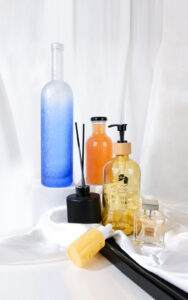The Complete Guide to Melting Point Of Glass
Introduction to Glass
Glass is typically made from sand and other materials, which are melted together at high temperatures. The result of this is a hard, clear material that doesn’t have a crystal structure. Glass is known as an amorphous solid because it lacks a defined arrangement of atoms. This structure is responsible for many unique glass properties, such as its transparency and melting point.
The melting point of glass is not a fixed value. It doesn’t melt like ice or metal. Instead, glass melts gradually across a temperature range, which is typically between 1400-1600°C. This melting point depends on what is in the glass, and it is also vital for applications across various industries.

Glass Composition and Properties
Composition
Glass is made up of different materials and can be made in many ways. The materials that go into it change how the glass melts. The regular kind of glass is made of silica sand, soda ash, and limestone. Other types add lead, boron, or aluminum. Each mix gives the glass a different melting temperature and strength.
Properties
The composition of glass affects its physical properties, and these properties change as it melts. The viscosity decreases as heat rises, making it easier to bend and stretch. The melting process changes the properties of glass, such as its color and strength. Heat also causes thermal expansion.
If the glass can’t stretch fast enough, it cracks, which is also known as thermal shock. This is why a steady heating rate is better.
Glass Melting Temperature
The glass melting temperature is the point at which it becomes soft enough to shape. Most glass melts between 1400-1600°C. But this depends on the type and amount of raw materials used. Fused silica glass melts around 1600°C. Lead glass melts much lower temperature, near 1000°C. The temperature range for melting also depends on the size and shape of the glass.
Additives like metal oxides or colors can also change the melting point and the way the molten glass flows. Understanding the glass melting temperature is crucial for controlling the melting process and producing a high-quality final product.
Types of Glass and Their Melting Point
Different glass types like soda lime glass, borosilicate glass, fused silica, and lead glass have distinct properties and melting points.
Soda lime glass

This is the most common type of glass. It is used to produce bottles, windows, jars, and some dishes as well. It has a relatively low melting point, typically between 1400°C – 1600°C (2550°F – 2910°F). It is very easy to shape, but it doesn’t handle thermal shock very well.
It has a low cost, thanks to soda ash (sodium carbonate), which reduces the melting point.
Borosilicate glass

This type of glass can be found in Pyrex, lab beakers, and ovens. Its melting range is between 1650°C to 1750°C, which is a higher range than soda lime. It has a high thermal shock resistance, making it able to resist cracks from fast heat changes.
Fused silica glass

This is made from pure silica, and it is used where strength is very necessary. It has a very high melting point, which is around 1600°C. This glass is hard to melt, but it is ideal for high-temperature applications, such as laboratory equipment and the manufacturing of semiconductors.
Quartz Glass

Quartz glass is almost pure silica as well, but it is even harder to melt than fused silica. It has a higher melting temperature range as well, which is between 1700°C – 2300°C. It is usually used in UV lamps, lasers, and semiconductor tools.
Lead glass

Lead glass has a lower melting point, which ranges between 1000°C – 1200°C. It contains lead oxide, which makes it very easy to shape and also gives it a shiny and reflective surface. You can find it mostly in crystal glassware.
Glass Melts and Formation
What are Glass Melts?

Glass melts are what you get when glass gets hot enough to become soft and flow. Most glass starts melting between 1400°C and 1600°C. This soft state is called molten glass. Once melted, the glass melts are thick and sticky. In this molten state, they can be blown, molded, or poured to get the desired shape.
Factors that Affect Formation
Heating Temperature
The melting temperature needs to be right and stable. If it is too low, the glass won’t be able to melt. If it’s too high, the material may break down, and additives can get burned. Every type of glass has its own melting point and temperature range.
The rate of heating matters a lot as well. If the glass is heated too quickly, it can cause bubbles or cracks. This happens because the outer layers expand faster than the inside. A slower heating rate reduces the risk of uneven melting and breakage.
Role of Chemical Composition
The type and mix of raw materials affect how glass melts. Basic glass uses silica, soda ash, and limestone. These help to create a soft, clear melt. Some examples are:
- Soda ash lowers the melting point of glass, saving heat and cost.
- Aluminium oxide (Al2O3) increases the high melting point, adding strength to the glass.
- Lead oxide lowers the melting point of glass and adds shine.
- Boron creates Borosilicate glass, which resists high heat.
Even small changes in the chemical composition can shift the melting temperature by hundreds of degrees. Knowing what mix to use helps keep the process safe and clean.
Additives and Their Effects
Additives also change the way glass melts. They are purposely added to mixes to get different kinds of results.
- Metal oxides can change the glass color and affect how it melts.
- Colorants like cobalt or copper give blue or green tints.
- Titanium or iron can change the shine or block light.
- Sodium carbonate helps lower the melting point and smooth out the melt.
These additives also affect how the viscosity decreases during heating. A lower viscosity means the glass flows better, which helps with pouring, blowing, or molding.
Understanding these factors is especially important for large-scale production. Making windows, bottles, or fiberglass all depend on high-quality glass melts. This full control helps avoid issues like uneven melting, bubbles, or weak glass. It also keeps energy use low, improving energy efficiency.
In some cases, factories use induction heating for better temperature control. They may also adjust for thermal expansion, especially with high-performance windows or laboratory equipment.
Can You Melt Glass at Home?
Yes, you can melt glass at home, but you need the right temperature and safe tools. Since the melting point of glass is very high, it will be too much for a kitchen oven to handle.
To melt glass at home, use a kiln or a high-powered torch. These can reach the needed melting temperature. A small kiln made for glasswork is the best tool to use. It heats evenly and also has safety features. On the other hand, a torch is better suited for small pieces.
Never try glass melting without safety gear. Always wear safety glasses, heat-resistant gloves, and protective clothing. You should also work in a well-ventilated space with good environmental controls.

Projects You Can Try
Melted glass can be used for many small projects. Here are some that you can try out:
- Fusing: This involves joining glass pieces by melting them together.
- Slumping: This is where you let softened glass droop over a mold.
- Recycling: You can melt old bottles or jars to form new shapes.
These use the same ideas as factory glass making, but at a smaller scale. However, laminated glass or advanced types like aluminosilicate glass are not recommended for home melting due to how complex they are.
Is Melted Glass Reusable?
Yes, glass can be melted and reused many times, which is known as recycling. Recycled glass is also known as cullet. It melts at lower temperatures than new glass because it has already been processed before. However, this process has its advantages and downsides.
Pros of Re-Melting Glass
- Saves Energy
- Re-melting used glass takes less energy than melting raw materials from scratch. Cullet has a lower melting point than fresh sand and soda ash. With lower energy, there are fewer costs and lower carbon emissions.
- Many factories now aim to use more cullet in their glass batches. The more they use, the less fuel they burn, and the easier it is to meet green rules set by governments or environmental groups.
- Reduces Waste
- Glass doesn’t break down easily on its own. If they are sent to landfills or dump sites, they can stay there for a very long time. Recycling one glass bottle means there’s one less bottle polluting the earth. And since glass can be used again and again, it’s a smart way to cut down on trash.
- Using recycled glass also means that factories don’t have to dig up as much sand or other raw materials. This helps to preserve natural land resources as well.
- Maintains Material Quality
- Some materials, like plastic or paper, lose quality each time you recycle them. They may get weaker or rougher, but glass is different. It can be melted and reshaped many times without losing its strength and performance.
Cons of Re-Melting Glass
- Contamination Issues
- Not all glass is made up of the same materials. Different glass types have different melting points, and if they are mixed together, it can lead to defects. A small bit of the wrong glass type can ruin a whole batch. This is why factories need to sort cullet very well.
- Higher Processing Requirements
- Sometimes, used glass doesn’t come clean. It may contain labels, food bits, or even small metal parts like bottle caps. All of these need to be removed before re-melting. If it is not done properly, the final product may contain flaws like uneven surfaces. Removing these extras needs extra equipment, cleaning systems, and careful checks.
- Not Suitable for All Glass Types
- Some special glass products can’t be remelted easily. Some of these include:
- Tempered glass which is often used in car windows or shower doors.
- Laminated glass in windshields.
- Ceramic glass in stovetops or oven windows.
- These types often have coatings, layers, or chemical treatments that prevent them from melting smoothly. If you try to remelt these types in a regular batch, they can mess up the furnace or produce bad glass.
Conclusion
Knowing the glass melting point is very important when you are working with it. If you’re in glass making, recycling, or shaping glass, getting the heat right helps to make it strong, useful, and safe. Let us help you with expert glass packaging for your next project.
FAQ: Glass Melting Temperatures
What’s the softening point vs. melting point?
The softening point is when the glass hasn’t fully melted yet, and it starts to bend or droop. The melting point is when it has turned into a molten or liquid state, where it can now be formed.
Why does glass not melt like metal?
Glass is an amorphous solid. It has no fixed melting point. Instead, it softens slowly over a temperature range. Unlike metal, it doesn’t go from solid to liquid form at one sharp temperature. It becomes sticky before it flows.
Can I use a regular oven to melt glass?
No. This is because most ovens reach only 300°C, which is far below the melting point of glass. Glass needs at least 1400°C, which only kilns or industrial furnaces can provide.
What’s the melting point of Pyrex?
Pyrex is made from borosilicate glass, which melts between 1650°C to 1750°C
Does recycled glass melt faster?
Yes. Recycled glass (cullet) melts at a lower temperature than raw glass. It flows faster and needs less heat.




